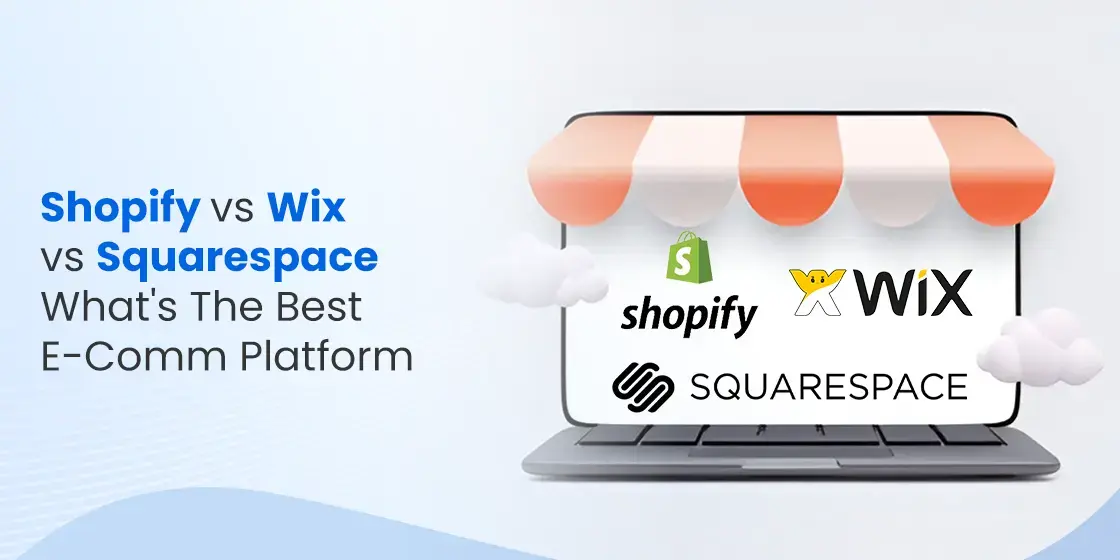Table of Content
Discover How Shopify vs Wix vs Squarespace Competition Shapes E-Commerce
Today, establishing a robust online presence is no longer a luxury but a necessity for businesses of all sizes looking to thrive and expand their reach. Venturing into e-commerce, choosing the right platform to host your online store is a pivotal decision that can significantly impact your success. Several platforms have emerged as frontrunners here, each offering a unique set of features, functionalities, and user experiences.
Among the most popular contenders are Shopify vs Wix vs Squarespace, each boasting millions of users worldwide and catering to a diverse range of e-commerce needs, from small startups to established enterprises.
Each platform presents its own distinct USP, making the “best” choice dependent on business requirements, technical expertise, and long-term aspirations. Shopify is lauded for its suite of e-commerce tools, Wix appeals to users who prioritize ease of use and creative freedom, while Squarespace has carved a niche among visually-driven businesses and individuals seeking a seamless and elegant online storefront.
Let’s take a look at how a web development agency would approach the choice between the three options, weighing the different pros and cons to find the best solution for their brand. Let’s find out.
What is Shopify?

Shopify is a dedicated e-commerce platform designed specifically for businesses looking to sell products and services online. Launched in 2006, it has grown into a global powerhouse, enabling millions of businesses across the world. Its strength lies in its comprehensive set of features tailored for e-commerce operations, making it a go-to choice for businesses of all sizes. Shopify operates on a subscription-based model, offering various plans with different features and pricing structures to accommodate diverse needs and budgets.
What Made Shopify So Popular?
At its heart, the platform provides users with all the essential tools to create and manage an online store. This includes customizable online storefronts with a wide array of professionally designed themes (both free and paid), and a secure and reliable payment processing system through Shopify Payments (plus integration with other payment gateways). Moreover, it offers robust inventory management capabilities to track stock levels and prevent overselling.
Similarly, Shopify also offers extensive marketing and SEO tools to help businesses attract customers, create and manage email campaigns, integrate with social media platforms, and optimize their store for search engines. The platform also boasts a powerful order management system for processing orders, fulfilling shipments, and handling returns, streamlining the entire post-purchase process.
One of Shopify’s standout features is its extensive app store, which provides access to thousands of third-party applications that can significantly extend the platform’s functionality. These apps cover a wide range of needs, including advanced marketing automation, dropshipping integrations, customer service tools, loyalty programs, and more.
This vast eCommerce software development ecosystem allows businesses to tailor their Shopify store precisely to their unique requirements and adapt to evolving market demands. Moreover, Shopify’s robust infrastructure is built to handle high transaction volumes and provides reliable uptime, making it a scalable solution for businesses with ambitious growth plans. Its dedicated focus on e-commerce ensures that businesses have access to a platform continuously updated with the latest industry best practices and features designed to maximize online sales.
Understanding Wix – A Site Builder, Or Something More?

Wix, established in 2006, initially gained prominence as a user-friendly website builder known for its drag-and-drop interface and extensive library of visually appealing templates. While its roots lie in general website creation, Wix has significantly expanded its e-commerce functionalities over the years, positioning itself as a versatile platform that caters to individuals and small businesses looking for an integrated website and online store solution.
Wix operates on a freemium model, offering a basic free plan with Wix branding and limited features, as well as various premium subscription plans that unlock more advanced capabilities, including e-commerce features.
What Does Wix Offer Its Users?
Wix’s core strength lies in its exceptional ease of use and the creative freedom it offers in website design. Its intuitive drag-and-drop editor allows users with little to no coding knowledge to create visually stunning and functional websites and online stores. Wix provides a wide selection of professionally designed templates that can be easily customized to reflect a brand’s unique identity. For e-commerce specifically, Wix offers features such as product galleries, shopping carts, secure checkout processes, and the ability to accept various payment methods.
It also provides tools for managing inventory, tracking orders, and calculating shipping rates. While its e-commerce features have matured considerably, they are generally considered more suitable for smaller businesses with less complex inventory and order management needs compared to dedicated e-commerce platforms like Shopify.
Wix also offers an app market, although it is smaller than Shopify’s, providing access to various third-party integrations and add-ons to enhance website and e-commerce functionality. These apps cover areas such as marketing, analytics, customer support, and payment processing. While Wix has made significant strides in its e-commerce offerings, its primary focus remains on providing a comprehensive and easy-to-use website building experience, with e-commerce as an integral, but perhaps not the sole, focus.
This makes it a compelling option for individuals and small businesses that prioritize design flexibility, ease of use, and require a tightly integrated website and online store without the advanced e-commerce specific features and scalability of platforms like Shopify. So if you want to know how to create a marketplace website easily, then Wix is a great option for you.
Demystifying Squarespace – The Newcomer to the Race

Squarespace, founded in 2003, has established a strong reputation for its sleek, modern aesthetic and its all-in-one platform that combines website building, hosting, and increasingly robust e-commerce capabilities.
Known for its beautifully designed templates and user-friendly interface, Squarespace appeals to individuals, creatives, and small businesses that prioritize visual presentation and a seamless, integrated online experience, over a comprehensive integration toolkit like Wix. Squarespace operates on a subscription-based model, offering various plans that include website hosting, security, and customer support, with dedicated e-commerce plans unlocking online selling features.
Looking for an experienced development team to manage your software projects? Get in touch with us now and hire skilled teams for your project.
Build My TeamDoes Squarespace Prove Itself Worth the Hype?
Squarespace’s core strength lies in its elegant design and its commitment to providing a cohesive and user-friendly platform. Its template library features sophisticated and visually appealing designs that cater to a wide range of industries and aesthetics. The platform’s intuitive interface allows users to customize these templates and build professional-looking websites and online stores without requiring extensive technical skills.
For e-commerce, Squarespace offers features such as product pages with multiple variations, secure checkout powered by Stripe (primarily), inventory management, order tracking, and the ability to offer discounts and promotions. It also provides basic marketing tools, including email marketing integrations and SEO features, to help businesses attract customers.
While Squarespace’s e-commerce functionalities have grown significantly over the years, they are generally considered to fall somewhere between the simplicity of Wix’s e-commerce offerings and the comprehensive feature set of Shopify. It is particularly well-suited for visually-driven businesses, such as those selling art, photography, design goods, or boutique products, where the aesthetic presentation of the online store is paramount.
Squarespace’s emphasis on a tightly integrated platform means that while it offers fewer third-party app integrations compared to Shopify and Wix, the features it does provide are generally well-integrated and contribute to a seamless user experience. This makes Squarespace a strong contender for individuals and small businesses that prioritize elegant design, ease of use, and a unified platform for both their website and online store needs. So if you want to know how to successfully make money with simple websites for eCommerce, Squarespace is a great option for you.
Shopify vs Wix vs Squarespace – What’s the Best Use for Each Platform?

The “best” e-commerce platform among Shopify, Wix, and Squarespace is not a universal answer but rather depends heavily on the specific needs and priorities of the individual or business. Each platform excels in different areas and caters to distinct user profiles.
Shopify is Generally the Best Choice For?
- Businesses with a strong focus on e-commerce: If your primary goal is selling online and you anticipate significant sales volume, Shopify’s robust e-commerce features, scalability, and extensive app store make it the most suitable option.
- Businesses with complex inventory and order management needs: Shopify’s advanced inventory tracking, order fulfillment tools, and integration capabilities are ideal for businesses with a large number of products or intricate shipping requirements.
- Businesses looking for extensive third-party integrations: Shopify’s vast app store offers a wide range of integrations to extend functionality in areas like marketing automation, accounting, and advanced analytics.
- Businesses with growth in mind: Shopify’s scalable infrastructure can handle increasing traffic and transaction volumes as your business expands.
Wix is Generally Preferred For?
- Individuals and small businesses prioritizing ease of use and design flexibility: Wix’s intuitive drag-and-drop editor and extensive template library make it exceptionally user-friendly for those with limited technical skills who want significant creative control over their website and online store’s appearance.
- Businesses that need a tightly integrated website and basic online store: If your e-commerce needs are relatively simple and you prioritize having your online store seamlessly integrated with a broader website offering information about your business, Wix provides a convenient all-in-one solution.
- Businesses with a smaller product catalog and less complex e-commerce operations: Wix’s e-commerce features are well-suited for businesses with a limited number of products and straightforward shipping and order management processes.
Squarespace is Ideally Chosen For?
- Visually-driven businesses and creatives: If the aesthetic presentation of your online store is paramount, particularly for businesses selling art, design goods, photography, or boutique products, Squarespace’s elegant templates and focus on visual design make it a strong contender.
- Individuals and small businesses seeking a seamless and elegant all-in-one platform: Squarespace’s integrated approach to website building, hosting, and e-commerce provides a cohesive and user-friendly experience without the need for extensive third-party integrations.
- Businesses with moderate e-commerce needs: While not as feature-rich as Shopify, Squarespace offers a solid set of e-commerce tools that are sufficient for many small to medium-sized businesses with relatively straightforward online selling requirements.
Pros and Cons of Each Platform – Shopify, Wix, and Squarespace

To further aid in your decision-making process, let’s dive into the specific pros and cons of each platform across three key areas: Usability, E-commerce Capabilities, and Cost to Use. Let’s begin.
Usability
| USABILITY OF VARIOUS PLATFORMS | ||
| Shopify | PROS | Offers a well-organized and intuitive backend specifically designed for e-commerce management. Provides clear navigation and logical workflows for managing products, orders, and customers. The Shopify App Store is easily accessible and simplifies the process of adding new features. |
| CONS | While generally user-friendly, the sheer number of features and settings can be overwhelming for absolute beginners. Customization beyond the theme often requires some knowledge of Shopify’s templating language, Liquid. | |
| Wix | PROS | Features an exceptionally user-friendly drag-and-drop editor that requires no coding knowledge. Offers a vast library of professionally designed templates that are easy to customize visually. The Wix App Market is integrated directly into the editor. |
| CONS | The drag-and-drop interface can sometimes lead to design inconsistencies if not used carefully. Once a template is chosen, switching to a different template can be difficult and may require significant rework. The platform can feel less structured than Shopify’s dedicated e-commerce focus. | |
| Squarespace | PROS | Known for its clean and intuitive interface with a focus on visual design. Offers a curated selection of high-quality, modern templates that are relatively easy to customize through built-in styling options. Provides a seamless and integrated experience for website building and e-commerce. |
| CONS | Offers less drag-and-drop flexibility compared to Wix, relying more on structured sections and customization options within the template framework. The app ecosystem is smaller than Shopify’s and Wix’s, potentially limiting advanced functionality without custom code. | |
eCommerce Capabilities
| CAPABILITY OF VARIOUS PLATFORMS | ||
| Shopify | PROS | Boasts a comprehensive suite of e-commerce specific features, including advanced inventory management, robust order processing, diverse payment gateway integrations (including Shopify Payments), sophisticated shipping options, and powerful marketing tools. Highly scalable to handle large product catalogs and high transaction volumes. |
| CONS | Some advanced features and integrations may require paid apps, adding to the overall cost. While Shopify Payments is convenient, transaction fees may apply depending on your plan and payment method. | |
| Wix | PROS | Offers a solid set of e-commerce features suitable for individuals and small businesses, including product galleries, shopping carts, secure checkout, inventory tracking, and basic order management. Supports various payment methods. |
| CONS | E-commerce features are generally less advanced than Shopify’s, particularly in areas like inventory management, shipping options, and marketing automation. The app market for e-commerce specific functionalities is less extensive than Shopify’s. May not be as scalable for very large or complex e-commerce operations. | |
| Squarespace | PROS | Provides a good balance of e-commerce features suitable for many small to medium-sized businesses, including product variations, secure checkout powered by Stripe, inventory management, order tracking, and basic marketing tools. Focuses on a visually appealing presentation of products. |
| CONS | E-commerce features are generally not as comprehensive or customizable as Shopify’s. Fewer third-party app integrations compared to Shopify and Wix may limit advanced functionality. Primarily relies on Stripe for payment processing. | |
Cost to Use
| COST TO USE VARIOUS PLATFORMS | ||
| Shopify | PROS | Offers various subscription plans with different features and pricing, allowing businesses to choose a plan that aligns with their needs and budget. |
| CONS | Can become more expensive as your business grows and you require more advanced features or higher-tier plans. Transaction fees may apply depending on the payment gateway used (unless using Shopify Payments). Paid apps can significantly increase the overall cost. | |
| Wix | PROS | Offers a range of premium plans, including e-commerce specific options, at generally competitive prices. Provides a basic free plan (with Wix branding and limited features) for those just starting out. |
| CONS | To access full e-commerce functionalities and remove Wix branding, a paid e-commerce plan is required. Additional features and integrations through the app market may incur extra costs. | |
| Squarespace | PROS | Offers straightforward subscription plans that bundle website building, hosting, and e-commerce features at generally competitive prices. |
| CONS | E-commerce features are locked behind specific (often slightly higher-priced) plans. Fewer options for lower-cost entry compared to Wix’s free plan. Limited app integrations may necessitate upgrading plans for certain functionalities. | |
Conclusion
Choosing the best e-commerce platform among Shopify vs Wix vs Squarespace ultimately boils down to a careful assessment of your specific business needs, technical comfort level, design preferences, and growth aspirations. By carefully considering the pros and cons of each platform across usability, e-commerce capabilities, and cost, you can make an informed decision that sets your online store up for success in the dynamic world of e-commerce.
Empower your digital initiatives with BariTechSol, a premier custom software development company. Our skilled team tailors cutting-edge solutions to your unique needs. Elevate your tech experience and stay ahead in the digital realm. Partner with BaritechSol and code the success of your next big idea.


